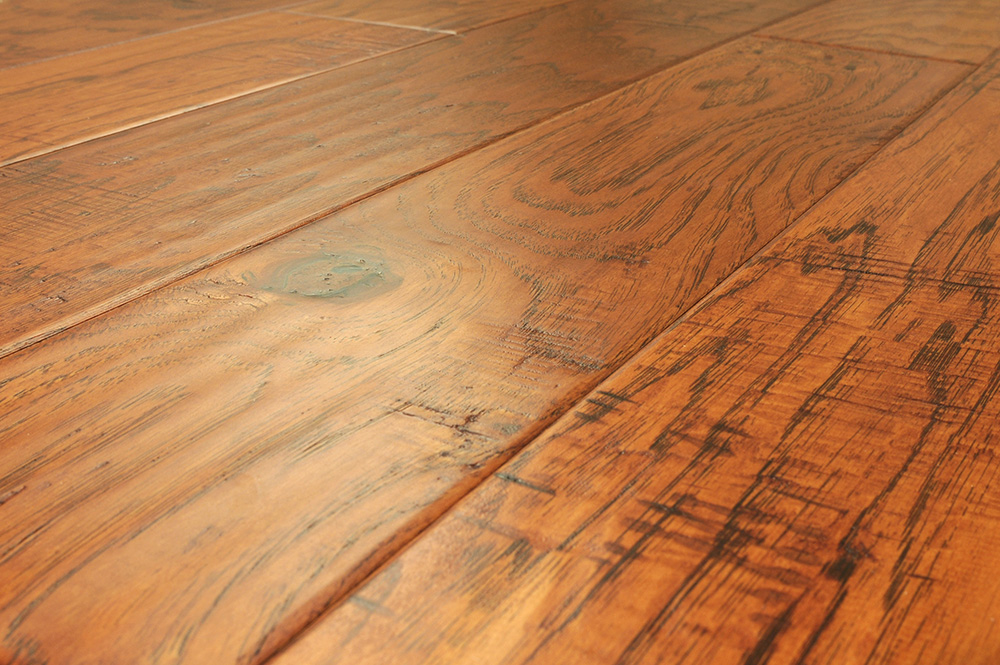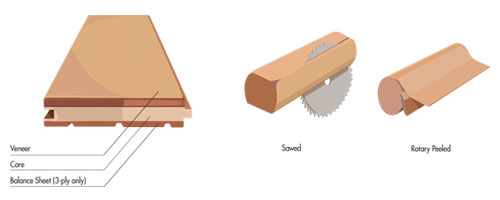What is Engineered Hardwood Flooring?
Engineered hardwood flooring is made by gluing a real hardwood veneer to a core board made of either plywood or high density fiberboard. Because of this construction method, engineered hardwood is more dimensionally stable than solid hardwood. In other words it will not contract or expand as much due to changes in humidity or temperature.
Engineered hardwood has several advantages over solid hardwood:
- It is generally less expensive than solid hardwood
- It can be installed on all grades, including below grade
- It can be installed over radiant heat
- It can be installed over a concrete subfloor
- It can be floated
The number of plies used to create the plywood core may vary anywhere from 2 to 10, and while a 3 ply board is not going to be as stable as say a 5 ply board would be, this is not enough to be a deciding factor unless this flooring is going to used over a radiant floor heating system. Generally speaking, the more plies in the plywood, the higher the price. A high density fiberboard core is more dimensionally stable than a plywood core.
There are three different ways of cutting the veneer for the engineered flooring that, along with thickness, has an impact on price. The three methods of cutting the veneer include:
- Dry solid-sawn: involves letting the wood dry out slowly with a low humidity level to keep moisture from inside the wood cells intact, reducing the risk of cupping. It is the most expensive type of engineered flooring, but looks and acts more like a solid.
- Rotary-peel: involves boiling the log for a certain amount of time at a certain temperature to prepare the wood. After the wood has been prepared, it is scraped from the log with a blade working from the outside in and then pressed flat. It typically has a plywood-like grain and can have issues with cupping and warping to try to revert to its original shape.
- Sliced-peel: involves boiling the log for a certain amount of time at a certain temperature to prepare the wood. After the wood has been prepared, it is sliced from the end and then pressed to create a veneer.
The thickness of the veneer ranges from 0.6 mm to 6 mm. The thicker the veneer, the more expensive the flooring is. For people who are planning to refinish the flooring at some point, it is important to consider the thickness because unlike a solid hardwood floor, the engineered type can only be sanded and refinished so many times. The thicker the veneer, the more times it can be sanded and refinished, however, it is still limited. Once installed, removing a vent to inspect the flooring from the side can provide an idea of the remaining thickness on the veneer.
Cannot be sanded & refinished:
- Engineered wood floors with veneer thickness less than 2mm
- Hand scraped engineered floors, regardless of veneer thickness
Can be sanded & refinished:
- Engineered wood floors with veneer thickness of 2mm or greater
Note: Sanding and refinishing an engineered wood floor with a veneer thickness of 2mm to 2.5mm is best left to a professional.
Engineered floor planks are made with either a traditional tongue and groove edge locking method or with a glueless click-lock edge method that requires no glue and allows the pieces to snap together to create a snug fit. This is the easiest do it yourself installation method.
For more information on the different types of hardwood flooring see our Types & Grades of Hardwood Flooring and our Hardwood Flooring Buying Guide.


